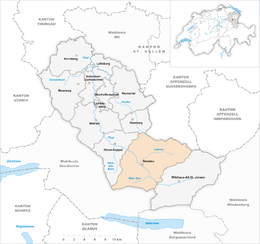Nesslau-Krummenau
| Nesslau | |
|---|---|

Nesslau village
|
|
| Coordinates: 47°13′N 9°12′E / 47.217°N 9.200°ECoordinates: 47°13′N 9°12′E / 47.217°N 9.200°E | |
| Country | Switzerland |
| Canton | St. Gallen |
| District | Toggenburg |
| Government | |
| • Mayor | Rolf Huber |
| Area | |
| • Total | 92.72 km2 (35.80 sq mi) |
| Population (Dec 2015) | |
| • Total | 3,611 |
| • Density | 39/km2 (100/sq mi) |
| Postal code | 9650 / 9651 / 9652 / 9643 / 9655 |
| SFOS number | 3360 |
| Surrounded by | Alt Sankt Johann, Amden, Ebnat-Kappel, Hemberg, Hundwil (AR), Schänis, Urnäsch (AR), Wildhaus |
| Website |
www SFSO statistics |
Nesslau is a municipality in the Toggenburg district of the canton of St. Gallen, Switzerland.
The current municipality was formed in 2013 and includes the villages of Nesslau, Krummenau and Stein.
The area was incorporated into the domains of the counts of Toggenburg and the Abbey of St. Gall from the 12th century. Nesslau is first mentioned in 1178 as Mezellouo. In 1261 it was mentioned as Nesselove and ze dem Wassere. In 912 the hamlet of Lutenwil was mentioned as Lutherraheimara. Krummenau is first mentioned in 1266 as Crumbenowe. Sidwald developed into a regional cattle market from the 16th century. After a series of fires in the benedictine abbey of St. John's in the upper Toggenburg, the monastery was moved to Neu St. Johann near Sidwald in 1626. From 1831 to 2002, Nesslau was the administrative center of the constituency of Obertoggenburg. The railway connecting Ebnat-Kappel to Nesslau-Neu St. Johann was opened in 1912, resulting in development of tourism in the region. The former municipality of Nesslau was merged with Krummenau into Nesslau-Krummenau in 2005. A further merger with Stein in 2013 resulted in the current municipality of Nesslau. The pre-2005 Nesslau had a different Community Identification Number (SFOS) (3355) and was smaller than the current municipality of Nesslau.
The new municipality of Nesslau has an area of 92.72 km2 (35.80 sq mi).
Nesslau-Krummenau had an area, as of 2006[update], of 80.4 km2 (31.0 sq mi). Of this area, 53.8% is used for agricultural purposes, while 36.5% is forested. Of the rest of the land, 3.2% is settled (buildings or roads) and the remainder (6.6%) is non-productive (rivers or lakes). The former municipality was located on both sides of the Thur river between the Speer and and from the Silberplatten in the Säntis range over the Schwägalp Pass to Mistelegg. After the merger in 2005 it was, in terms of land area, the third largest municipality in the canton. It consists of the villages of Nesslau, Krummenau, Neu St. Johann, Dorf and Ennetbühl as well as the hamlets of Lutenwil, Krümmenschwil, Büel, Schneit, Laad, Schlatt (until the merger an exclave of Nesslau in Krummenau), Aemelsberg and Beiereggbis.
...
Wikipedia



